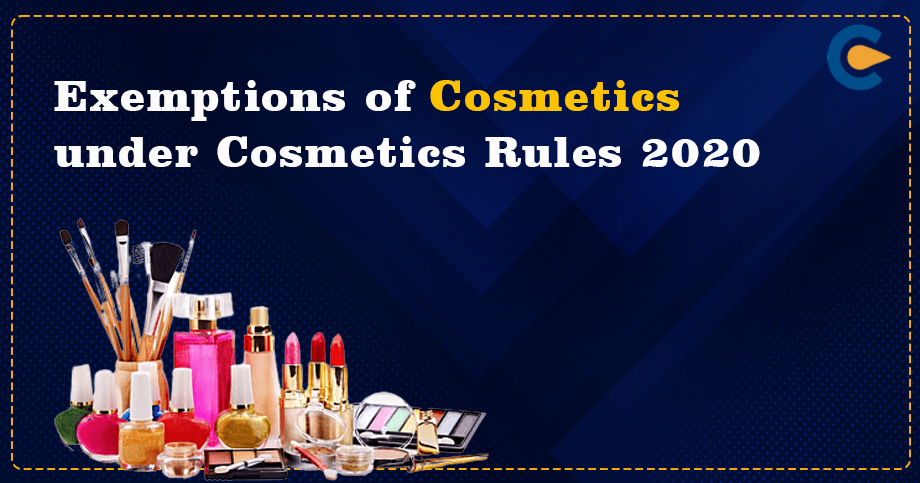The Ministry of Health and Family Welfare[1], India, notified the Cosmetic Rules 2020 in continuation to the powers conferred upon it under the valid provisions of the Drugs and Cosmetics Act, 1940, to separate and organise rules for effective compliance. It is also essential that all licenses must be granted before the notification under the Drugs and Cosmetics Act, 1940 (old rules) will continue to be valid until the expiration date or period from the notification date of these rules. According to the Drugs & Cosmetics Act, 1940 and Cosmetics Rules 2020, the State Drug Control Department inspects and grants cosmetics license approval to importers & manufacturers in India. Additionally, the import of cosmetics products is governed by a registration system administered under the Central Drug Standard Control Organization (CDSCO), which regulates cosmetics activities and propagates corresponding regulations. This blog will focus on Exemptions of Cosmetics under Cosmetics Rules, 2020.
What are Cosmetics?
Before we discuss the Exemptions of Cosmetics under Cosmetic Rules, 2020, first know the meaning of Cosmetics. As per the Drugs and Cosmetics Act & Rules, cosmetics in India are described as products designed to be massaged, poured, streaked, sprayed on, introduced into, or otherwise applicable to, the human’s body or any part thereof for purifying, beautifying, promoting attractiveness, changing the appearance, and involves any article designed to use as a component of cosmetic.
Exemptions of Cosmetics as per 12th Schedule: Section Rule 64(1)
Following are Exemptions of Cosmetics as per 12th Schedule Section Rule 64(1):
| Sr. No. | Class of Cosmetics | Extent & Conditions of Exemptions 0f Cosmetics |
| 1. | Cosmetics | The provisions of “Chapter IV” of the Act & Rules thereunder need them to be covered through a licence for cosmetics Sale, provided that the cosmetics products sold, in case of Indian origin, are Manufactured by licensed manufacturers. |
| 2. | The following categories of cosmetics: (i) Cosmetics in bulk for repackaging for 100 per cent export to other countries. (ii) Cosmetics for research & development purposes like packaging trials, customer studies, shelf life studies & transport studies. (iii) Cosmetics for Sale to foreign travellers in duty-free shops in international airports. (iv) Cosmetics in amenity kits for the exclusive use of foreign passengers on a complimentary basis, if not for domestic sale. (v) Cosmetics imported for use in hotels exclusively for their captive consumption & after providing a notarised undertaking to this effect. | The provisions of Chapter III of the Act and rules thereunder required them to be covered through a registration certificate subject to the following condition- The cosmetics shall not be used for Indian (domestic) Sales. |
| 3. | Hair Fixers, namely mucilaginous Preparations containing gums, used by men for fixing beard. | The provisions of Chapter IV of the Act and the Rules thereunder. |
| 4. | Cosmetics are imported as a Kit to be marketed in India, wherein all individual products are already registered for Import into India under Cosmetics Rules, 2020. | The provisions of Chapter III of the Act and Rules thereunder required them to be covered by a Registration Certificate. |
Prohibitions or Restrictions Outlined
According to direct in the Drugs & Cosmetics Act 1940 and New Cosmetics Rules 2020, multiple products are forbidden when manufacturing & importing cosmetics to adhere to the standards that are stipulated through BIS:
- It is prohibited to import or manufacture cosmetics containing colours, dyes and pigments that don’t comply with BIS Specifications. Colours & Pigments used in cosmetics products shall be those listed by the BIS (IS: 4707 Part 1 as amended) and Schedule-Q. Cosmetics may contain not exceed the following natural & synthetic organic colours:
- Two parts by million concentrations of arsenic are calculated as arsenic trioxide.
- Twenty parts by million concentrations of lead are calculated as the lead.
- One hundred parts by million concentration of heavy metals other than lead are calculated as the total of the respective metals.
- Cosmetics containing hexachlorophene are prohibited from being imported or manufactured.
- Cosmetics containing lead or arsenic for colouring cosmetics are prohibited through manufacturing or importation.
- Cosmetics imported into India and manufactured domestically shall be predominately mercury-based. The percentage of mercury proportion should be:
- The level of mercury, calculated as the metals, should not be more than seventy parts by million (o.oo7 %) in cosmetics intended for use only in the eye area.
- As far as finished cosmetics products are concerned, unintentional mercury levels need not more than one part per million (1 ppm).
- Importation of cosmetics products that have been tested on animals has prohibited by the Drugs & Cosmetics (Fifth Amendment) Rules, 2014, prohibiting the importation of any cosmetics that have been tested on animals after their introduction.
Conclusion – Exemptions of Cosmetics
Cosmetics products imported into India in bulk can be repackaged for 100 per cent export outside India without a registration certificate. An importer needs to give a written undertaking that these cosmetic products are not released for domestic Sale. The importer will have an essential registration certificate from the CDSCO. The importer of cosmetics for Research & Development objectives like packaging trails, shelf-life tests, consumer studies, etc. don’t need to get a registration certificate. However, they need to get permission from the concerned port offices of CDSCO in such cases. The importer must state that these products will not be released to the Indian market.
Read our Article:An Overview of Cosmetic Rules 2020













